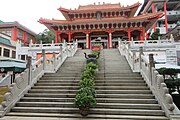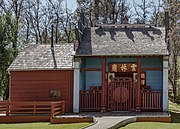Taoist temple
| Part of a series on |
| Taoism |
|---|
 |
A Taoist temple (traditional Chinese: 觀; simplified Chinese: 观; pinyin: guàn, also called 道观 dàoguàn and 宫观, literally "[place] where the Tao is observed/cultivated") is a place of worship in Taoism.
Structure and function can vary according to the Taoist school the temple belongs to. For example, guàn of the Quanzhen School are monasteries where celibate Taoist priests live.
The title gōng (traditional Chinese: 宫) "palace" is often used for large temples built with imperial or governmental patronage.[citation needed]
Taoist temples imitate many Buddhist construction methods. In front of the main gate are the holy statues of Dragon and Tiger. The Three Pure Ones are worshipped inside. Taoist temples are carved with Chinese characters like Fu (blessing), Shou (longevity), Ji (auspicious), reflecting the theme of long and fruitful life.[1]
Gallery[]

Exterior of the Xianguding Temple (traditional Chinese: 仙姑頂; simplified Chinese: 仙姑顶; pinyin: Xiāngūdǐng), a daoguan in Weihai, Shandong, China
Chun Yang Dian of Ching Chung Koon Temple (青松觀), Hong Kong

Fung Ying Seen Koon Temple (蓬瀛仙館), Hong Kong

Yun Lin Temple, oldest Taoist temple in California, United States
San Qing Gong Temple, Singapore

Interior of the Leong San See temple, Singapore
See also[]
| Wikimedia Commons has media related to Taoist temples. |
- Taoism
- Way of the Celestial Masters
- Zhengyi Taoism
- Quanzhen Taoism
- Chinese ritual mastery traditions
- Chinese temple
- Cebu Taoist Temple (Cebu City, Philippines)
References[]
- Taoist temples
- People's Republic of China religious building and structure stubs
- Taoism stubs







